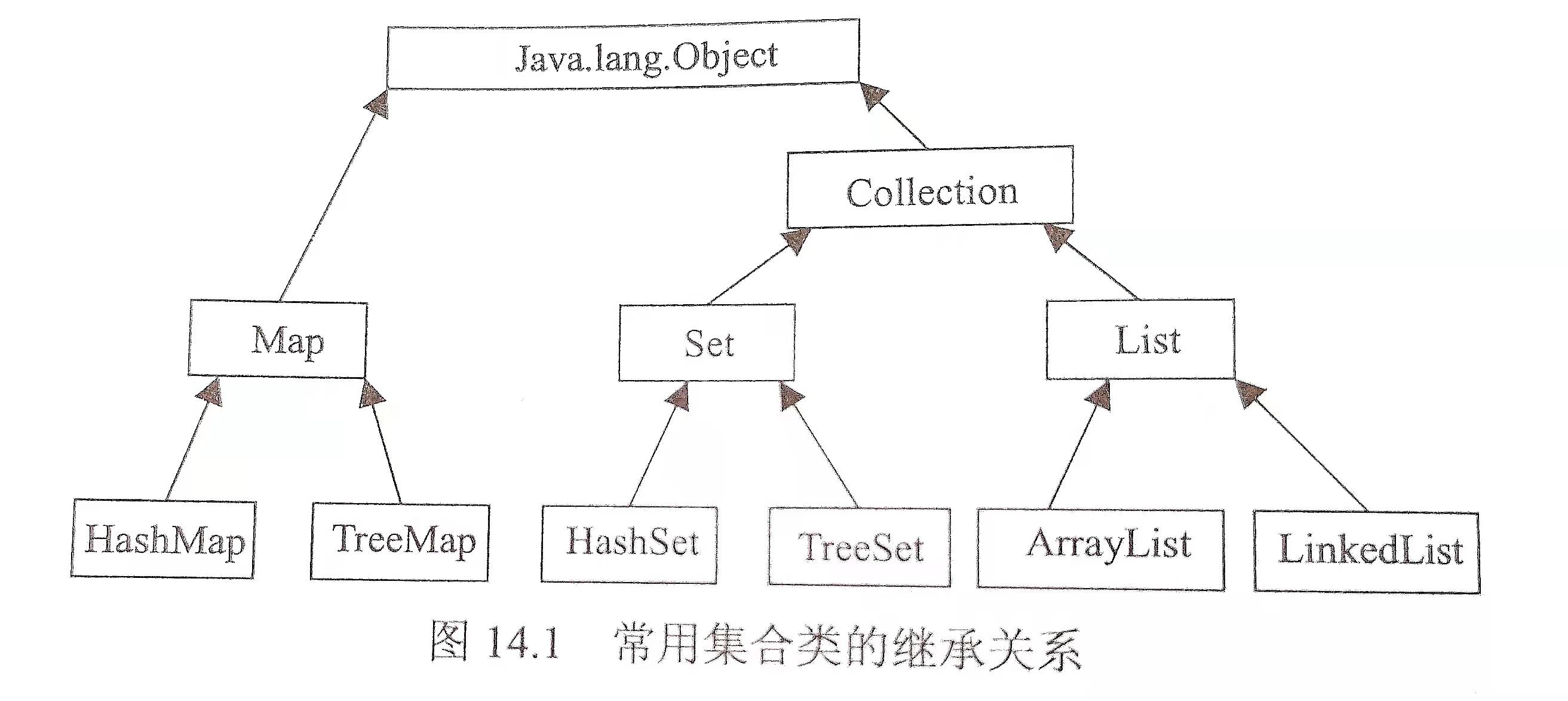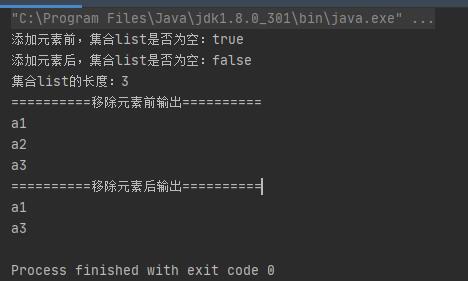Java常用集合类概述ArrayListLinkedListHashSetTreeSetHashMapTreeMap
Posted 江州益彤
tags:
篇首语:本文由小常识网(cha138.com)小编为大家整理,主要介绍了Java常用集合类概述ArrayListLinkedListHashSetTreeSetHashMapTreeMap相关的知识,希望对你有一定的参考价值。
一、集合类概述

二、Collection接口

package com.dgut.test;
import java.text.SimpleDateFormat;
import java.util.ArrayList;
import java.util.Collection;
import java.util.Date;
import java.util.Iterator;
public class Test001
public static void main(String[] args)
Collection<String> list = new ArrayList<>();//创建一个ArrayList类型对象
System.out.println("添加元素前,集合list是否为空:"+list.isEmpty());//使用isEmpty()方法判断集合是否为空
list.add("a1");//使用add()方法向集合添加数据
list.add("a2");
list.add("a3");
System.out.println("添加元素后,集合list是否为空:"+list.isEmpty());
System.out.println("集合list的长度:"+list.size());//使用size()方法获取集合的长度
Iterator<String> iterator01 = list.iterator();//使用iterator()获取元素在集合上的迭代器,用于遍历集合中的元素
System.out.println("==========移除元素前输出==========");
while(iterator01.hasNext())
String str = (String) iterator01.next();//Iterator的next()放回的是Object
System.out.println(str);
System.out.println("==========移除元素后输出==========");
list.remove("a2");//使用remove()移除集合中的元素
iterator01 = list.iterator();
while(iterator01.hasNext())
String str = (String) iterator01.next();//Iterator的next()放回的是Object
System.out.println(str);

三、List集合
3.1、ArrayList
package com.dgut.test;
import java.util.*;
public class Test001
public static void main(String[] args)
List<String> strList = new ArrayList<String>();
strList.add("a1");
strList.add("a2");
strList.add("a3");
strList.add("a4");
System.out.println("ArrayList输出strList.get(1):" + strList.get(1));//使用get()获取索引对应的值
strList.set(0, "b1");//使用set()修改索引对应的值
strList.remove(2);//使用remove()移除索引对应的值
strList.remove("a4");//使用remove()移除指定对象
for (int i=0;i<strList.size();i++)//使用size()获取集合长度
System.out.println("=======" + strList.get(i));

3.1、LinkedList
package com.dgut.test;
import java.util.*;
public class Test001
public static void main(String[] args)
List<String> strList = new LinkedList<String>();
strList.add("a1");
strList.add("a2");
strList.add("a3");
strList.add("a4");
System.out.println("LinkedList输出strList.get(1):" + strList.get(1));//使用get()获取索引对应的值
strList.set(0, "b1");//使用set()修改索引对应的值
strList.remove(2);//使用remove()移除索引对应的值
strList.remove("a4");//使用remove()移除指定对象
for (int i=0;i<strList.size();i++)//使用size()获取集合长度
System.out.println("=======" + strList.get(i));

四、Set集合
4.1、HashSet
package com.dgut.test;
import java.util.*;
public class Test001
public static void main(String[] args)
HashSet<String> sites = new HashSet<String>();
sites.add("Google"); //使用add()方法添加对象到集合
sites.add("Runoob");
sites.add("Taobao");
sites.add("Zhihu");
sites.add("Runoob"); // 重复的元素不会被添加
System.out.println("删除元素前集合:" + sites);
//判断元素是否存在
System.out.println("判断元素'Taobao'是否存在" + sites.contains("Taobao"));
System.out.println("判断元素'Taobao001'是否存在" + sites.contains("Taobao001"));
System.out.println("可以使用 for-each 来迭代 HashSet 中的元素。");
for (String i : sites)
System.out.println(i);
sites.remove("Taobao"); // 删除元素,删除成功返回 true,否则为 false
System.out.println("删除元素后集合:" + sites);
sites.clear(); //删除集合中所有元素可以使用clear方法:
//如果要计算 HashSet 中的元素数量可以使用 size() 方法:
System.out.println("使用clear方法删除集合中所有元素后集合大小:" + sites.size());

4.2、TreeSet
五、Map
5.1、HashMap
HashMap 是一个散列表,它存储的内容是键值对(key-value)映射。
HashMap 实现了 Map 接口,根据键的 HashCode 值存储数据,具有很快的访问速度,最多允许一条记录的键为 null,不支持线程同步。
HashMap 是无序的,即不会记录插入的顺序。
HashMap 继承于AbstractMap,实现了 Map、Cloneable、java.io.Serializable 接口。
clear() 删除 hashMap 中的所有键/值对
clone() 复制一份 hashMap
isEmpty() 判断 hashMap 是否为空
size() 计算 hashMap 中键/值对的数量
put() 将键/值对添加到 hashMap 中
putAll() 将所有键/值对添加到 hashMap 中
putIfAbsent() 如果 hashMap 中不存在指定的键,则将指定的键/值对插入到 hashMap 中。
remove() 删除 hashMap 中指定键 key 的映射关系
containsKey() 检查 hashMap 中是否存在指定的 key 对应的映射关系。
containsValue() 检查 hashMap 中是否存在指定的 value 对应的映射关系。
replace() 替换 hashMap 中是指定的 key 对应的 value。
replaceAll() 将 hashMap 中的所有映射关系替换成给定的函数所执行的结果。
get() 获取指定 key 对应对 value
getOrDefault() 获取指定 key 对应对 value,如果找不到 key ,则返回设置的默认值
forEach() 对 hashMap 中的每个映射执行指定的操作。
entrySet() 返回 hashMap 中所有映射项的集合集合视图。
keySet() 返回 hashMap 中所有 key 组成的集合视图。
values() 返回 hashMap 中存在的所有 value 值。
merge() 添加键值对到 hashMap 中
compute() 对 hashMap 中指定 key 的值进行重新计算
computeIfAbsent() 对 hashMap 中指定 key 的值进行重新计算,如果不存在这个 key,则添加到 hasMap 中
computeIfPresent() 对 hashMap 中指定 key 的值进行重新计算,前提是该 key 存在于 hashMap 中。
package com.dgut.test;
import java.util.*;
public class Test001
public static void main(String[] args)
// 创建 HashMap 对象 Sites
HashMap<Integer, String> Sites = new HashMap<Integer, String>();
// 添加键值对
Sites.put(1, "Google");
Sites.put(2, "Runoob");
Sites.put(3, "Taobao");
Sites.put(4, "Zhihu");
System.out.println("初始HashMap集合:" + Sites);
//使用 get(key) 方法来获取 key 对应的 value:
System.out.println(Sites.get(3));
//使用 remove(key) 方法来删除 key 对应的键值对(key-value):
Sites.remove(4);
System.out.println("删除HashMap集合中key=4对应的值后的HashMap集合:" + Sites);
//计算 HashMap 中的元素数量可以使用 size() 方法
System.out.println("HashMap 中的元素数量:" + Sites.size());
//使用 for-each 来迭代 HashMap 中的元素
// 输出 key 和 value
for (Integer i : Sites.keySet())
System.out.println("key: " + i + " value: " + Sites.get(i));
// 返回所有 value 值
for(String value: Sites.values())
// 输出每一个value
System.out.print(value + ", ");
//删除所有键值对(key-value)可以使用 clear 方法:
Sites.clear();
System.out.println("\\n使用 clear 方法删除所有键值对:" + Sites);

5.2、TreeMap
以上是关于Java常用集合类概述ArrayListLinkedListHashSetTreeSetHashMapTreeMap的主要内容,如果未能解决你的问题,请参考以下文章